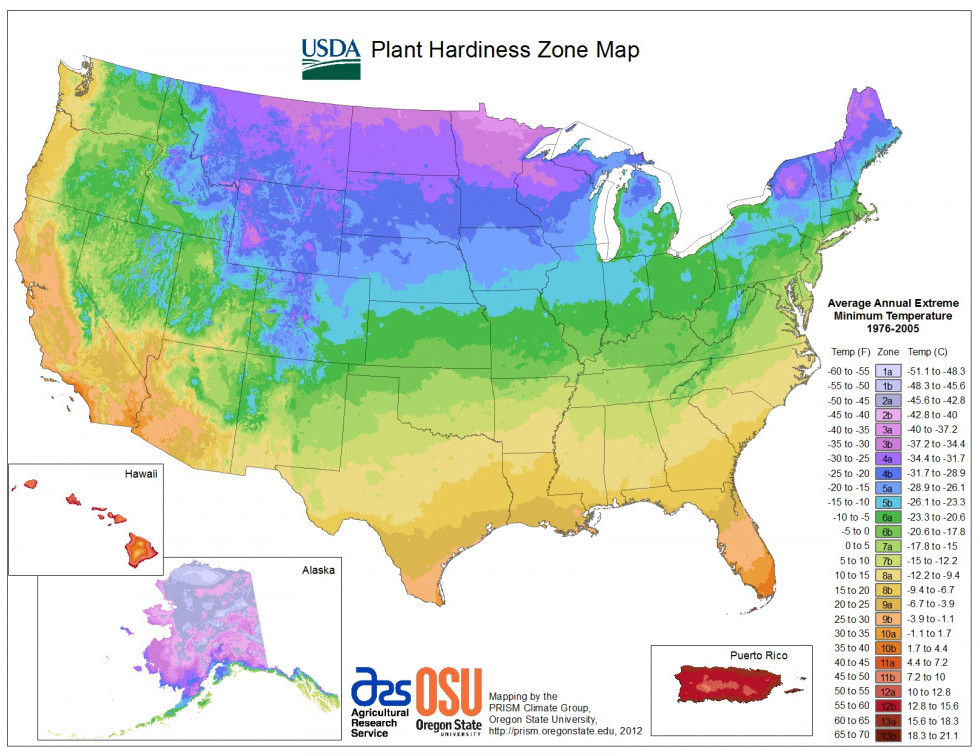Starting garden seeds indoors – A beginners guide
Standing in your garden on a warm spring morning is a good feeling. The air smells earthy and scented with spring growth as the birds sing. The sun feels warm after a long cold winter. But the garden started long before the snow melted. Starting a garden from seeds often starts indoors to get a jump on the season. It helps for earlier garden harvests and blooms or just to squeeze in a plant that needs a longer growing season. It’s easy for anyone to learn to garden. But where do you begin starting a garden from seeds indoors and what do you need to be successful?
What you need for starting garden seeds indoors
Before you begin to plant your seeds you should create a plan for your garden. This will help you know how much time and work you want to put into your garden. Once outside mother nature will take over but indoors you will need to provide everything your seedlings require. Your new seedlings will need these 5 things listed below. Most can be easily be produced using things you may already have.
Light
This can be artificial light supplied by florescent or LED fixtures or a sunny window. If you use grow lights, grow light bulbs which have a color temperature range of 5000 – 7000K are typically more expensive than the daylight tubes (5000K – 6500K) that I choose to grow my seedlings. I find the less expensive ones work just fine to get seeds to the transplant stage, although every once in a while I throw in a single grow light bulb just to see if I get any difference.
Window locations are great if you have an area large enough for what you want to plant. Try out windows facing different directions to see which works best. (morning sun, afternoon sun, all day sun facing south). Be careful if you place too close to a window, on the sill for example. The glass can act like a magnifier in direct sunlight and dry out or burn up your seedlings. Avoid drafts that can inhibit germination or stunt growth. Check your plants as they begin to sprout and try in different areas if you need to.
Heat
Heat can be achieved in a variety of ways. Inside your home a warmer area of the house may be sufficient. A sunny kitchen window for example where the sunlight heats your container and kitchen cooking helps to warm things. I used to grow my plants in the laundry area where temperature and humidity from the washer and dryer made a perfect environment. I just added lighting and the plants loved it. Now I have an area in my basement with a simple oil filled radiator in an area surrounded by cheap plastic drop cloth to contain the heat. You can also get heat mats that are placed below your seed starting trays to speed germination and does not require heating the space in an entire area. Also, florescent lights will typically generate some heat as you will want to set them only a few inches above the plants.
Soil
Start with a good seed starting mix for best results. This will help a lot to avoid damping off, which is a fungus or mold that prefers cool wet conditions. You can grow in any kind of soil but a good seed starting mix can help to inhibit these conditions. More on that later.
Water
If you can keep a container of water drawn and set aside so that the water is room temperature when you water your seedlings. Water from the tap will still work but cold water can slow down things by cooling the soil for a time and sitting allows time for chlorine to diffuse out of the water which affects some houseplants adversely so I like to do the same for my seedlings. I like to put the water into a cheap spray bottle to start off watering my seeds. This way it does not disturb the soil or beat down the new plants as they emerge and as they get large enough and the soil more stable I take off the spray attachment and the bottleneck helps more regulate and direct where I poor the water into the trays to not over water.
Space
Look around your house. Locate your space and allow enough space for your plants to grow and spread out. If you start in smaller size seed trays and transplant into packs or flats, for example, you will need to allow enough space for the larger containers as your garden grows. If you start directly into your packs then the expansion won’t be as great but realize the leaves will grow wider than the footprint of the packs as your plants grow.
When to plant your seeds
Choosing the right plants to grow for your area is important to understand for success. Your seed packets will list the growing zone they are suited for. Then check the USDA plant hardiness zone map to see which growing zone you are in. Check your growing zone for the average date of last frost in your area. Use the information from your seed packet or out of your catalog to tell how many weeks ahead you need to plant before setting out. Then count the number of weeks backwards from the average last date of frost for your growing zone.
Preparing to plant your seeds indoors
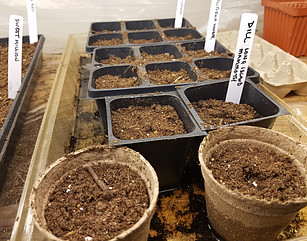
Choosing your containers
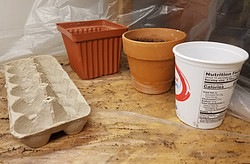 Containers can be anything that will hold the soil and allow it to drain properly and fit into the space you have designated. I have used store bought trays (new or recycled from previous plants), old clay pots, egg cartons or disposable plastic containers. Clear covers can help hold a level amount of humidity starting off. This can again be store bought or be as simple as clear plastic wrap or glass or Plexiglas you may have lying around. It just needs to be convenient to remove to water when needed and allow enough height for the plants to get started.
Containers can be anything that will hold the soil and allow it to drain properly and fit into the space you have designated. I have used store bought trays (new or recycled from previous plants), old clay pots, egg cartons or disposable plastic containers. Clear covers can help hold a level amount of humidity starting off. This can again be store bought or be as simple as clear plastic wrap or glass or Plexiglas you may have lying around. It just needs to be convenient to remove to water when needed and allow enough height for the plants to get started.
Choosing your soil
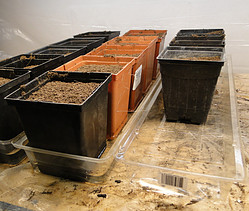
I start my seeds using seed starting mix bought at my local market or garden store. I like it because it is easy to maintain proper moisture for my seedlings and has a fine texture to allow planting even the tiniest seeds. It is important that your soil drains well so your seedlings don’t drown or dampen off. This is a disease that can occur in over watered soil.
Beginning a day or two before planting moisten the seed mix by adding water and letting it be absorbed. Bottom watering is best when possible. Set your containers in a tray such as the one pictured here and add water. I used old plastic seed tray covers here. This will also help reduce the risk of damping off.
Let’s begin planting your seeds
The depth you need to plant your seeds can vary based on seed size and other needs of individual varieties. The pencil in this image helps gives you an idea of their size. Seeds pictured here are from top left to bottom right:
1) Snap dragon 2) zinnia 3) marigold 4) cucumber 5) dill 6) salvia 7) borage 8) tomato
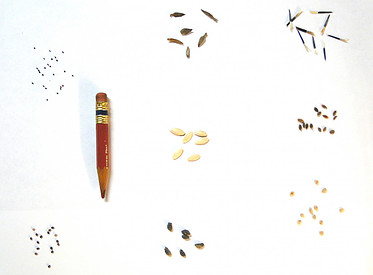
The series of pics below covers how to plant most common varieties of seeds. Many seed packets instruct you to plant at a specific depth, such as 1/4″, or may say plant to thickness, cover lightly, or press into soil / sow on surface. I will show how you plant for any of these directions. Some seeds will require light to germinate and there are a few that require total darkness during the entire germination process.
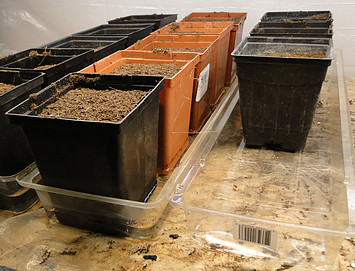 Pre-moisten your seed mix
Pre-moisten your seed mix
Start with your pre-moistened soil in your chosen containers. This makes it much easier to work with less likely to displace seed when watering in because the soil will already be settled.
Refer to your seed packet as to how deep to cover seed or if it is just pressed into the surface.
 Firming the soil
Firming the soil
Firm the soil gently by hand but don’t pack it. This will help give you an even surface for planting and remove any large pockets under the soil that would settle out when watering and displace your seed to deep.
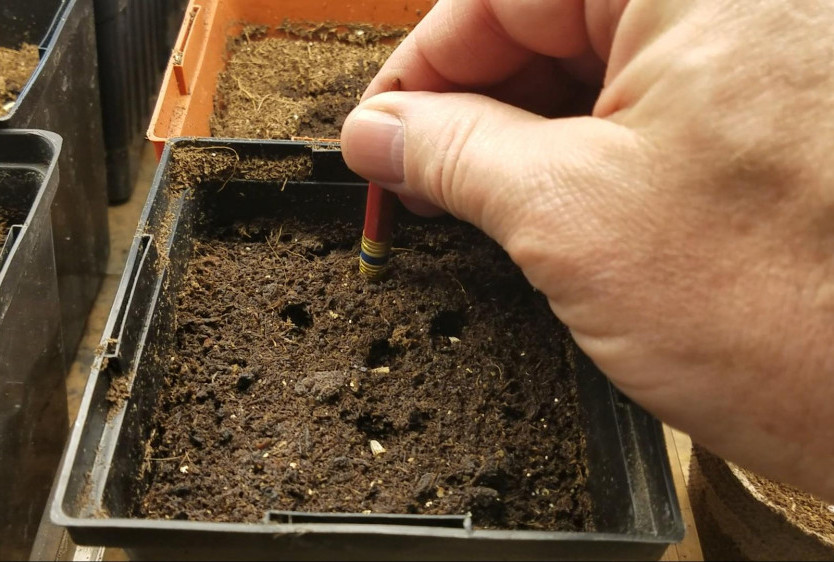 Planting in holes
Planting in holes
You can use a pencil to press into the soil and make holes for planting medium to large seeds such as tomatoes, peppers, cabbage or broccoli as examples. This worn eraser head was perfect for measuring about 1/4″ depth. Larger seeds such as cucumber, squash and other vine plants You can just press into the soil with your finger. Use the top edge of your fingernail to measure about 1/2″ or up to your first knuckle for 1″.
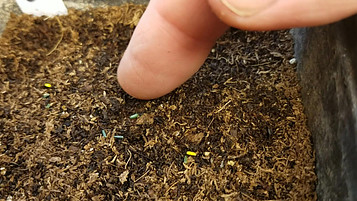
Planting on the surface – lightly covering
Some seeds, mainly very tiny seeds, need planted on the surface. For some such as the Rudbeckia in this image it is because they need light to germinate. You can scatter or place in rows on the surface and may just lightly firm the soil to make sure they have good contact. The seeds here are the tiny blue and yellow specs. If lightly covering or sowing to thickness I just sprinkle a little seed mix by hand over the seed until I do not see it.
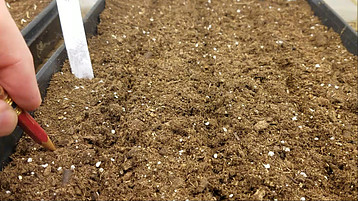
Planting in rows
To save space I plant many of my garden varieties in trays arranged in rows and later transplant into packs after they grow big enough. This can be really helpful if you have a limited space to heat high enough for germination. Once sprouted, temperature isn’t as critical to remain so high and I move them further from the heat source and put new seeds to start nearer the heat. You can create shallow furrows easily using a pencil. Once seeds are dropped in, pinch closed with your fingers.
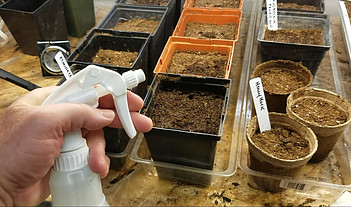
Watering in
I use an inexpensive spray bottle to water in after planting. This helps the seeds to settle in and get good soil contact and doesn’t displace them. Knowing the seed mix has been well moistened beforehand I watch the surface for color changes showing it is drying out and continue to water gently with a spray bottle until they develop roots deep enough from the surface to allow my bottom watering alone to be effective. But, if the surface looks wet, don’t over water.
Conclusion
Whether you are just beginning or have seasons of experience, starting garden seeds indoors gives you a head start by extending your growing season. You can enjoy fresh vegetables earlier and longer, flowers that can bloom from spring to fall, and expand the varieties available to you. You don’t have to be limited to what you find at your local markets and garden stores.
My father used to say “plants grow in spite of people, not because of people”. That can be true. You just need a few minutes of time each day to see how your garden is doing and give it just the right amount of care. If it needs it. Gardening can be easy for anyone. Join me for my next post on transplanting and hardening off your new seedlings.
If you have questions or suggestions about this post please leave a comment below.
Happy planting!
